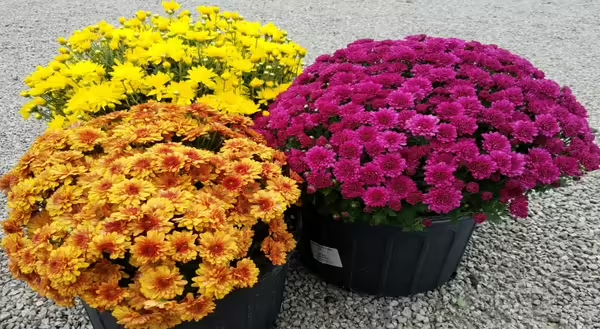
Throughout the fall season, garden centers are filled with a beautiful selection of mums (short for chrysanthemums). In the garden, mums provide a both a spectacular fall display and a late season nectar source for pollinating insects.
It is a wonderful time to plant these attractive, fall-blooming plants, but some consideration should be given when planting in fall. Many folks plant mums and don’t actually do much to encourage flowering, but there are also some measures you can take earlier in the season that will result in additional beauty at bloom time.
Why do mums bloom in fall?
Mums are photoperiodic which means they respond to changing day length in the fall. So, when our days begin to shorten in fall that is their cue to start flowering. “Short-day” plants, like mums, flower when day length is less than 12 hours and some varieties have been developed to flower earlier or later in fall based on their genetics. This is typically identified on plants for sale in garden centers, with wording like “early season” or “late season”.
Late season mums are often overlooked by gardeners because they appear somewhat bland at the garden center. While they are full of green flower buds waiting to burst open when days are short enough, they don’t have the showy, brilliant color of earlier varieties that are in full bloom right now. Its hard to resist the urge to buy a plant filled with flowers, but why not enjoy the entire bloom in your home garden? By purchasing the less showy, later season varieties, you can bring home a plant with its full bloom time still awaiting.
Are mums perennial in Illinois?
Mums are typically perennial in our area, although some colder winters may kill them. Most planting guides recommended spring planting for mums if you would like them remain in your garden as perennials. However, fall planting is the common practice since plants are readily available and often have showy flowers at that time.
Typically, mums die in winter because that their shallow, fibrous roots system may get frozen as the upper soil layers freeze and thaw over winter. When mums are planted in fall, their root system may still be fairly small when winter sets in, as opposed to spring-planted mums which have an entire growing season to develop a larger root system.
How can I ensure my mums are healthy?
To ensure the winter survival mums, site selection is an important consideration. Mums prefer well-drained soil, so don’t plant them areas with poor drainage or occasional standing water. They also prefer full sun (greater than 6 hours of sunlight per day), which is needed for plants to thrive and produce large, extensive roots that can survive winter stress. If you have a more protected spot that is, closer to you home, south-facing and out of the wind, mums will do better there. Avoid planting mums near outdoor lights as it may confuse day length and inhibit flower formation.
Mulching can greatly reduce winter stresses and help protect roots during wintertime. Plan on adding some additional mulch to your mums at the end of fall as blooming begins to wane. Many mum growers will recommend cutting them back as the end of the season, but research has shown that mums survive better if old growth is left standing for the winter season with an adequate mulch layer (4 in thick).
Once your overwintered mums pop up out of the mulch in spring, greater blooms can be encouraged by pruning them early in the growing season. When mums reach about 4-6 inches of growth in spring, prune off the growing tips of all stems with shears or simply pinch them off with your fingers. This encourages lateral growth which will result in a shorter, but bushier plant. Prune the tips one or two more times before July when bud growth begins. The additional lateral growth, instead of leggy, upward growth, will result in a multitude of blooms when the fall days shorten.